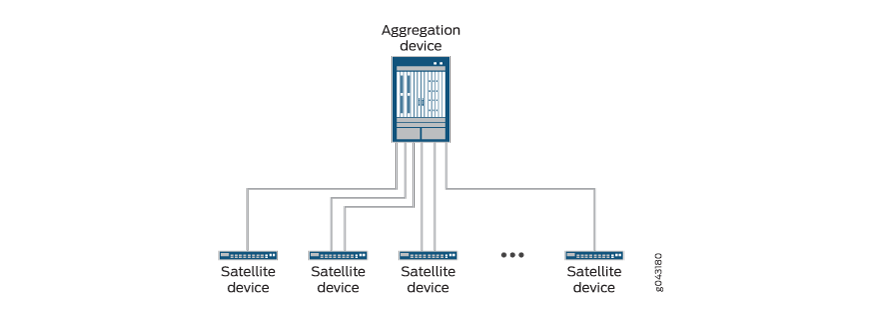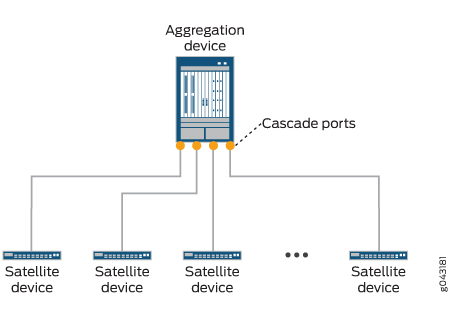Understanding Junos Fusion Provider Edge Components
This topic describes the components of a Junos Fusion Provider Edge.
This topic covers:
Junos Fusion Topology
The Junos Fusion topology is composed of an aggregation device and multiple satellite devices. Each satellite device has at least one connection to the aggregation device. The satellite devices provide interfaces that send and receive network traffic. Network traffic can be forwarded over the aggregation device within the Junos Fusion.
See Figure 1 for an illustration of the Junos Fusion topology.

The satellite devices and the aggregation device maintain the control plane for the Junos Fusion using multiple internal satellite management protocols. Junos Fusion supports the IEEE 802.1BR standard.
The aggregation device acts as the single point of management for all devices in the Junos Fusion. All Junos Fusion management responsibilities, including interface configuration for every satellite device interface in the Junos Fusion, are handled by the aggregation device. The aggregation device runs Junos OS software for the entire Junos Fusion, and the interfaces on the satellite devices are configured from the aggregation device and support features that are supported by the version of Junos OS running on the aggregation device.
Aggregation Devices
An aggregation device:
Has at least one connection to each satellite device.
Runs Junos OS software for the entire Junos Fusion.
Manages the entire Junos Fusion. All Junos Fusion configuration management is handled on the aggregation device, including interface configuration of the satellite device interfaces.
The hardware specifications for aggregation devices in a Junos Fusion Provider Edge are discussed in greater detail in Understanding Junos Fusion Provider Edge Software and Hardware Requirements.
Satellite Devices
A satellite device:
Runs a version of satellite software after being converted into a satellite device.
Has at least one direct connection to the aggregation device.
Provides network interfaces to send and receive traffic for the Junos Fusion.
Is managed and configured by the aggregation device.
The hardware specifications for satellite devices in a Junos Fusion Provider Edge are discussed in greater detail in Understanding Junos Fusion Provider Edge Software and Hardware Requirements.
Cascade Ports
A cascade port is a port on an aggregation device that sends and receives control and network traffic from an attached satellite device. All traffic passed between a satellite device and the aggregation device in a Junos Fusion traverses the cascade port.
The link that connects an aggregation device to a satellite device has an interface on each end of the link. The interface on the aggregation device end of the link is a cascade port. The interface on the satellite device end of the link is an uplink port.
Satellite devices are added to a Junos Fusion by configuring the interface on the aggregation device end of a link into a satellite device.
A cascade port is typically but not limited to a 10-Gbps SFP+ interface or a 40-Gbps QSFP+ interface, but any interface on the aggregation device that connects to the satellite device can be converted into a cascade port.
The location of the cascade ports in a Junos Fusion are illustrated in Figure 2.

The hardware specifications for cascade ports in a Junos Fusion Provider Edge are discussed in greater detail in Understanding Junos Fusion Provider Edge Software and Hardware Requirements.
Uplink Ports
An uplink port is a physical interface on a satellite device that provides a connection to an aggregation device. All network and control traffic on a satellite device that is transported to an aggregation device is sent or received on the satellite device’s uplink port.
The link that connects an aggregation device to a satellite device has an interface on each end of the link. The interface on the aggregation device end of the link is a cascade port. The interface on the satellite device end of the link is an uplink port.
Uplink ports are automatically created when a cascade port is configured on the aggregation device end of the link.
A single satellite device supports multiple uplink port connections to an aggregation device. The multiple uplink ports connections to a single aggregation device provide redundancy and additional bandwidth for satellite device to aggregation device connections.
An uplink port is typically but not limited to a 10-Gbps SFP+ interface or a 40-Gbps QSFP+ interface, but any 1-Gbps interface on the aggregation device that connects to the satellite device can also be converted into a cascade port.
Extended Ports
An extended port is a network-facing port on a satellite device that transmits and receives network traffic for the Junos Fusion.
Network traffic received on an extended port is passed, when appropriate, to the aggregation device over the uplink port to cascade port link.
Each network-facing port on a satellite device in a Junos Fusion is also an extended port. A single cascade port is associated with multiple extended ports.
Understanding FPC Identifiers and Assignment in a Junos Fusion Fabric
In a Junos Fusion, each satellite device must have an FPC identifier (FPC ID).
The FPC ID is used for Junos Fusion configuration, monitoring, and maintenance. Interface names—which are identified using the type-fpc / pic / port format—use the FPC ID as the fpc variable when the satellite device is participating in a Junos Fusion. For instance, built-in port 2 on PIC 0 of a satellite device—a gigabit Ethernet interface on a satellite device that is using 101 as it’s FPC ID— uses ge-101/0/2 as it’s interface name.
A Junos Fusion provides two methods of assigning an FPC identifier:
Unique-ID based FPC identification
Connectivity-based FPC identification
In unique-ID based FPC identification, the FPC ID is mapped to the serial number or MAC address of the satellite device. For instance, if a satellite device whose serial number was ABCDEFGHIJKL was assigned to FPC ID 110 using unique-ID based FPC identification, the satellite device with the serial number ABCDEFGHIJKL will always be associated with FPC ID 110 in the Junos Fusion. If the satellite device with the serial number ABCDEFGHIJKL connects to the aggregation device using a different cascade port, the FPC ID for the satellite device remains 110.
In connectivity-based FPC identification, the FPC ID is mapped to the cascade port. For instance, connectivity-based FPC identification can be used to assign FPC ID 120 to the satellite device that connects to the aggregation device using cascade port xe-0/0/2. If the existing satellite device that connects to cascade port xe-0/0/2 is replaced by a new satellite device, the new satellite device connected to the cascade port assumes FPC ID 120.
Unique-ID based FPC identification is configured using the serial-number or system-id statement in the [edit chassis satellite-management fpc slot-id] hierarchy.
Connectivity-based FPC identification is configured using the cascade-ports statement in the [edit chassis satellite-management fpc slot-id] hierarchy.
If a prospective satellite device is connected to a Junos Fusion without having a configured FPC slot ID, the prospective satellite device does not participate in the Junos Fusion until an FPC ID is associated with it. The show chassis satellite unprovision output includes a list of satellite devices that are not participating in a Junos Fusion due to an FPC ID association issue.
Understanding Software in a Junos Fusion
In a Junos Fusion, the aggregation device is responsible for all configuration and management within the Junos Fusion and runs Junos OS software.
The satellite devices, meanwhile, run satellite software that has the built-in intelligence to extend the feature set on the Junos OS software onto the satellite device.
The role of Junos OS and satellite software is discussed in greater detail in Understanding Software in a Junos Fusion Provider Edge.
The software specifications for a Junos Fusion Provider Edge are discussed in greater detail in Understanding Junos Fusion Provider Edge Software and Hardware Requirements.
Understanding Interface Naming in a Junos Fusion
Network interfaces in Junos OS are specified as follows:
type-fpc / pic / port
In a Junos Fusion, the interface names on the satellite devices follow this naming convention, where:
The type does not change for the interface when it becomes part of a Junos Fusion. The type for an
xeinterface, for instance, remainsxeregardless of whether the interface is or isn’t in a Junos Fusion.You will see internally created
sdinterfaces in a Junos Fusion. Thesdinterfaces map to uplink ports, and are used internally by the Junos Fusion to process some types of traffic.The fpc identifier in a Junos Fusion, which is user-configurable, is the FPC slot identifier. See Understanding FPC Identifiers and Assignment in a Junos Fusion Fabric.
For instance, built-in port 2 on PIC 0—a gigabit Ethernet interface that is acting as an extended port—on an EX4300 switch that is acting as FPC slot 101 would be identified as:
ge-101/0/2
